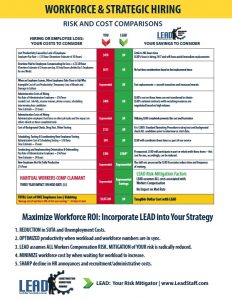Employees are the heart of a company. However, employee labor can take up a large portion of a company’s budget. And, when companies need to find a way to make ends meet, often, labor cost is one of the first line items to be reviewed. Keeping costs down or within a manageable range that meets the budget is important to running a successful business. Aaron Taylor, LEAD National, Managing Partner and recruiting industry veteran, specializing in the construction and industrial skilled trades, says, “Many businesses can cut their labor costs by using a staffing company like LEAD.” But, before taking that step, Aaron recommends calculating your labor percentage cost.
Understanding Cost of Labor Percentage
The cost of labor percentage is the overall payroll outlay for a business and is considered a portion of the gross sales.  Aaron says, “It is important for businesses to track labor costs; it’s key to finding labor issues and cost-saving opportunities.” Follow the three steps below to get to your labor percentage.
Aaron says, “It is important for businesses to track labor costs; it’s key to finding labor issues and cost-saving opportunities.” Follow the three steps below to get to your labor percentage.
Collect Sales Information
Use the revenue, or gross sales, from your business’ income statement to calculate the employee labor percentage for a year. You can measure a shorter length of time by using information from interim sales reports.
Calculate Labor Cost
Add up your payroll which includes all costs for labor: salaries, wages, social security tax, and benefits. Be sure to include bonuses, commissions, and other compensation.
Calculate the Cost of Labor Percentage
An average of 20 to 35 percent of gross sales is considered a typical labor cost percentage. However, this largely depends on the industry,” says Aaron. To calculate the percentage, divide the labor cost by gross sales and multiply by 100. For example, if gross sales are $400,000 and the total labor cost is $120,000. Divide $120,000 by $400,000 and multiply by 100. Your employee labor percentage equals 30 percent.
Keeping Labor Costs Down
“Whether a company uses a staffing firm or employs its own hiring department, keeping costs down or within a manageable range that meets budget is important to running a successful business,” says Aaron. Small businesses, especially, often don’t have the luxury of a full financial and/or HR team to control costs. Keeping labor costs within the expected range will help the business on its growth track.
Work with LEAD National to Reduce Labor Costs
Whether you choose to reduce your workforce, or a skilled trade worker leaves to pursue other opportunities, loss of productivity is inevitable and costly. Aaron explains, “Lost productivity caused by lack (or loss) of the employee, plus overtime paid to employees compensating for the loss could cost on average $1125 per employee loss. Whereas, it costs the company nothing if they use LEAD for their staffing needs.”
Additionally, recruiting and hiring replacement(s) are costly. “Using a staffing company like LEAD also can save a company during the hiring process. LEAD National handles the administrative costs of hiring, scheduling, testing, and coordinating new employee testing which can save a company an average of $570 per new hire,” says Aaron.
Aaron also explains that by using LEAD, the hiring risk is out of your hands. If you are not happy with an employee, we will replace them. You have not made a time investment in reviewing resumes, screening, testing, or hiring. We cover workers’ compensation and unemployment costs as well as taking the stress out of hiring the “wrong” person.
After determining your labor percentage and further assessing your labor costs, if you find your company is spending too much on labor or the hiring process, call Aaron Taylor at LEAD National today. Plus, send us your name and email to  receive LEAD’s Workforce and Strategic Hiring Risk and Cost Comparison sheet to learn about the costs to consider when hiring or reducing your workforce and the savings you may realize if you choose LEAD National for your staffing solution. Email Aaron at ATaylor@leadstaff.com.
receive LEAD’s Workforce and Strategic Hiring Risk and Cost Comparison sheet to learn about the costs to consider when hiring or reducing your workforce and the savings you may realize if you choose LEAD National for your staffing solution. Email Aaron at ATaylor@leadstaff.com.


